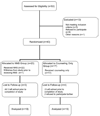A randomized trial of nicotine nasal spray in adolescent smokers
- PMID: 18762494
- PMCID: PMC2744418
- DOI: 10.1542/peds.2008-0501
A randomized trial of nicotine nasal spray in adolescent smokers
Abstract
Objectives: Nicotine nasal spray has been 1 of the most successful forms of nicotine-replacement therapy in adult populations. The nasal sprayer has not been studied in adolescent smokers. The objective of this pilot study was to determine the feasibility and utility of using nicotine nasal spray for adolescent smokers who wanted to quit smoking.
Methods: Forty adolescent smokers who were between 15 and 18 years of age and smoked >/=5 cigarettes daily for at least 6 months were recruited from several San Francisco Bay area schools from 2005 to 2007. Using a randomized, open-label, 12-week trial, adolescent smokers were assigned to receive either weekly counseling alone (control) for 8 weeks or 8 weeks of counseling along with 6 weeks of nicotine nasal spray. Self-reported smoking abstinence was verified by both expired-air carbon monoxide and salivary cotinine.
Results: There was no difference in cessation rates, the numbers of cigarettes smoked per day, or cotinine levels at 12 weeks. Fifty-seven percent of participants stopped using their spray after only 1 week. The most commonly reported adverse effect was nasal irritation and burning (34.8%) followed by complaints about the taste and smell (13%).
Conclusions: The unpleasant adverse effects, poor adherence, and consequent lack of efficacy observed in our pilot study do not support the use of nicotine nasal spray as an adjunct to counseling for adolescent smokers who wish to quit.
Comment in
-
Nicotine nasal spray neither effective nor well-tolerated by adolescent smokers.J Pediatr. 2009 Mar;154(3):462-3. doi: 10.1016/j.jpeds.2008.11.046. J Pediatr. 2009. PMID: 19874770 No abstract available.
References
-
- Centers For Disease Control. Preventing tobacco use among young people: A report of the Surgeon General. Morbidity and Mortality Weekly Report. 1994;43(RR4):I–IX. 1–10. - PubMed
-
- Lynch B, Bonnie R. Growing up tobacco free: preventing nicotine addiction in children and youths. Washington, D.C: National Academy Press; 1994. - PubMed
-
- Sussman S, Dent CW, Severson H, Burton D, Flay BR. Self-initiated quitting among adolescent smokers. Preventive Medicine: An International Journal Devoted to Practice & Theory. 1998;27(5 Pt 3) - PubMed
-
- Moss AJ, Allen KF, Giovino GA, Mills SL. Recent trends in adolescent smoking, smoking-uptake correlates, and expectations about the future. Adv Data. 1992;117(221):1–28. - PubMed
-
- Hurt RD, Dale LD, Frederickson PA, et al. Nicotine patch therapy for smoking cessation combined with physician advice and nurse follow-up: One-year outcome and percentage of nicotine replacement. JAMA (Journal of the American Medical Association) 1994;271(8):595–600. - PubMed
Publication types
MeSH terms
Substances
Grants and funding
LinkOut - more resources
Full Text Sources
Medical


